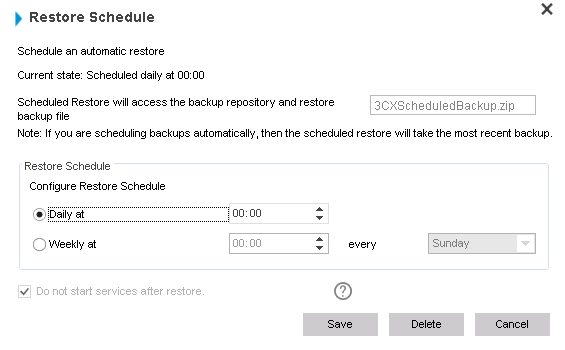Configuring fault tolerance in 3CX Version 14
In 3CX Phone System, the failover feature allows you to create a copy of the PBX and if the primary station refuses to work, you can switch to the backup with minimal loss of time and data.

One domain name. For example, 3cx.contoso.com
Two 3CX Phone System Version 14 installed on 2 different servers in split DNS mode.
Both servers should be identical in terms of setup, domain name, SSL certificates, SIP, Tunnel, ports, and type of web server.
How it works:

1. Go to the admin area of Server 1 . We suggest that this is the main PBX 3CX Phone System V14 and it is already configured.
2. Go to Backup and restore> Location and specify where to backup.

3. In this example, backups are stored in the C: \ Backups folder. If you have FTP, you can configure it, but local storage is easier and faster.

4. Click Backup Schedule and specify what should be included in the backup and how often it should be created. It is recommended to do at least once a day, at night. In our example, at midnight, the backup is saved to the C: \ 'Backups folder with the name 3CXScheduledBackup.zip
5. Using the “robocopy” utility (available in windows), make a script to copy the 3CXScheduledBackup.zip file from the C: \ Backups folder to the backup server, for example \\ passiveserver \ backups . In this case, the command will be:
robocopy C: \ Backups \ \\ passiveServer \ Backups "3CXScheduledBackup.zip"
6. Configure the automatic launch of the script an hour after the main backup — in the example 1 am.

7. Go to Backup and restore and click Failover . Turn on Failover and select Active .
Now we have an active server that backs up to the C: \ Backups folder and a script that copies the backup to the backup server. Now you need to configure the second server - Passive automatically restore the backup and replace the Active server if it fails.
')
1. Go to Server 2 and install 3CX Phone System
2. In admin panel go to Backup and restore> Failover

3. Enable the Enable Failover option.
4. Select Passive

5. In the Failover Settings section, click the Configure button and configure the recovery schedule.
6. Specify the IP address of the remote server (in our case it is the Active server ) - in Example 1.1.1.1
7. Select services to monitor: Sip Server, Webserver, or Tunnel Server.
8. Specify the status check interval (by default 15 seconds) and actions in case the main server is not available.
9. You can configure additional actions - you can run scripts before and after a failure. In the example, we use a script that connects to the DNS server and changes the IP address to the Passive Server address in A records. Also, if at least one service fails, we turn off the main server. Sample scripts can be found here .
After clicking OK, the Passive server will stop its services and start monitoring the Active server . If the main PBX is unavailable for any of the reasons, the Passive server will run scripts and take over the PBX functions.

Requirements
One domain name. For example, 3cx.contoso.com
Two 3CX Phone System Version 14 installed on 2 different servers in split DNS mode.
Both servers should be identical in terms of setup, domain name, SSL certificates, SIP, Tunnel, ports, and type of web server.
How it works:

Step 1: Configure the ACTIVE SERVER
1. Go to the admin area of Server 1 . We suggest that this is the main PBX 3CX Phone System V14 and it is already configured.
2. Go to Backup and restore> Location and specify where to backup.

3. In this example, backups are stored in the C: \ Backups folder. If you have FTP, you can configure it, but local storage is easier and faster.

4. Click Backup Schedule and specify what should be included in the backup and how often it should be created. It is recommended to do at least once a day, at night. In our example, at midnight, the backup is saved to the C: \ 'Backups folder with the name 3CXScheduledBackup.zip
5. Using the “robocopy” utility (available in windows), make a script to copy the 3CXScheduledBackup.zip file from the C: \ Backups folder to the backup server, for example \\ passiveserver \ backups . In this case, the command will be:
robocopy C: \ Backups \ \\ passiveServer \ Backups "3CXScheduledBackup.zip"
6. Configure the automatic launch of the script an hour after the main backup — in the example 1 am.

7. Go to Backup and restore and click Failover . Turn on Failover and select Active .
Now we have an active server that backs up to the C: \ Backups folder and a script that copies the backup to the backup server. Now you need to configure the second server - Passive automatically restore the backup and replace the Active server if it fails.
')
Step 2: Configure PASSIVE SERVER
1. Go to Server 2 and install 3CX Phone System
2. In admin panel go to Backup and restore> Failover

3. Enable the Enable Failover option.
4. Select Passive

5. In the Failover Settings section, click the Configure button and configure the recovery schedule.
6. Specify the IP address of the remote server (in our case it is the Active server ) - in Example 1.1.1.1
7. Select services to monitor: Sip Server, Webserver, or Tunnel Server.
8. Specify the status check interval (by default 15 seconds) and actions in case the main server is not available.
9. You can configure additional actions - you can run scripts before and after a failure. In the example, we use a script that connects to the DNS server and changes the IP address to the Passive Server address in A records. Also, if at least one service fails, we turn off the main server. Sample scripts can be found here .
After clicking OK, the Passive server will stop its services and start monitoring the Active server . If the main PBX is unavailable for any of the reasons, the Passive server will run scripts and take over the PBX functions.
Download
Source: https://habr.com/ru/post/278045/
All Articles